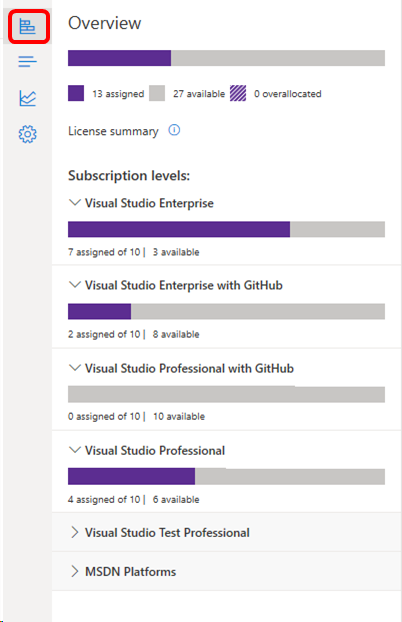Note
Access to this page requires authorization. You can try signing in or changing directories.
Access to this page requires authorization. You can try changing directories.
Sometimes orders are changed after subscribers have been added, which can result in having more assigned subscriptions than licenses owned by your company, which is called "over-allocation."
To see your subscription allocations, select the top icon at the left to open the overview pane.
Note
Over-allocations are not allowed in Open License programs. Also, other programs may display this information in the portal differently.

The display uses a hashed bar to indicate over-allocated subscriptions. The number of over-allocations across all subscription types is included in the Overview section at the top, and each subscription level also displays its own allocation status.
Receive notifications when over-allocations occur
You can designate an email address to receive notifications when overallocations occur, and set a threshold that must be exceeded before notifications are sent. Learn more about setting preferences for your agreements in the admin portal.
Resolve over-allocated subscriptions
There are several ways to resolve over-allocations:
- Contact your reseller to purchase more subscriptions.
- Wait until your annual true-up period and pay for the over-allocated subscriptions at that point.
- Delete some subscription assignments. (The true-up still takes place based on the maximum number of subscriptions assigned at any time during the year.)
Billing and true-up
If your organization has an Enterprise Agreement (EA), admins are able to assign subscriptions without purchasing them, and pay for them later through a reconciliation process known as a "true-up." When you over-allocate, your organization is billed for the maximum number of subscriptions assigned to users during the "true-up." The billing takes place even if you no longer have the maximum number of subscriptions assigned at the time the true-up takes place. To learn more about monitoring your maximum usage, visit the Maximum Usage article.
See also
- Visual Studio documentation
- Azure DevOps Services documentation
- Azure documentation
- Microsoft 365 documentation
Next steps
- Learn more about managing Visual Studio subscriptions with GitHub Enterprise.
- For assistance with sales, subscriptions, accounts and billing for Visual Studio Subscriptions, contact Visual Studio Subscriptions Support.